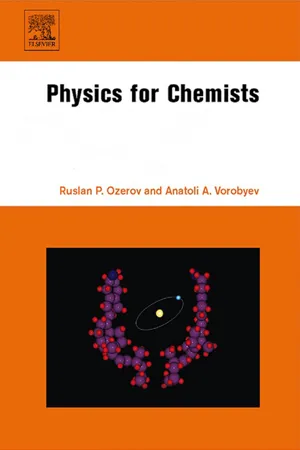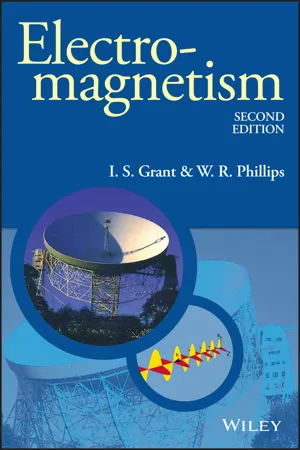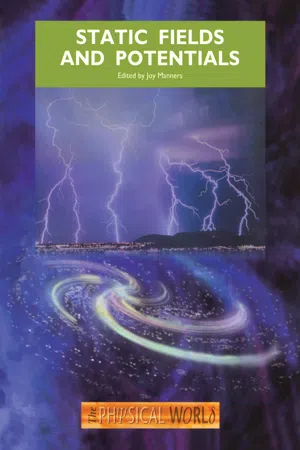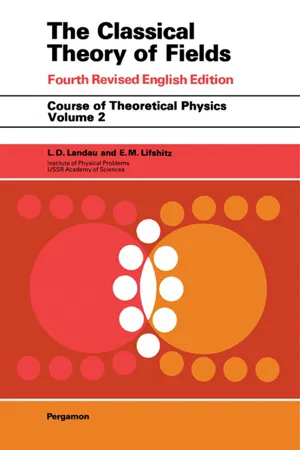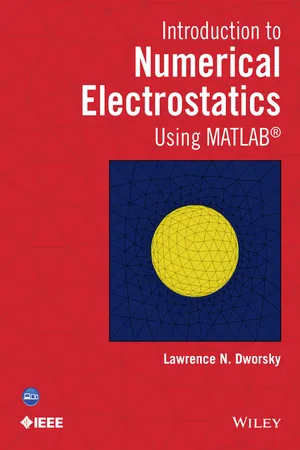Chemistry
Electric Fields Chemistry
Electric fields in chemistry refer to the force fields that surround charged particles, influencing the behavior of other charged particles within their vicinity. These fields are created by the presence of electric charges and play a crucial role in understanding chemical reactions, particularly those involving ions and polar molecules. Understanding electric fields is essential for comprehending the interactions and behavior of charged species in chemical systems.
Written by Perlego with AI-assistance
Related key terms
Related key terms
1 of 4
Related key terms
1 of 3
11 Key excerpts on "Electric Fields Chemistry"
- eBook - ePub
- Ruslan P. Ozerov, Anatoli A. Vorobyev(Authors)
- 2007(Publication Date)
- Elsevier Science(Publisher)
From the point of view of electric properties, all substances can be divided into two main classes—conducting and nonconducting an electric current. Metals, their alloys, and a small number of chemical compounds with metal character of interatomic interactions relate to the class of conductors. The second class includes other substances and represents the overwhelming majority. Conductivity is defined by the presence of free charge carriers in a substance; their absence determines dielectric properties. So, dielectrics are substances in which there are no free charges capable of covering long distances in the substance. Depending on their molecular structure, all dielectrics can, in turn, be divided into two large groups—polar and nonpolar. In polar dielectrics, molecules themselves represent the electric dipoles with the electric moment; it appears due to displacements of electric charges from positions of their equilibrium in free atoms as a result of chemical bonding. The molecular dipoles of polar dielectrics participate in thermal motion; this can be translational motion (in gases and liquids), oscillation about equilibrium positions (solids and liquids) and rotation around the center of mass. As a result, the dipole electric moments are chaotically distributed along directions.Electric and magnetic interactions play an enormous role in chemistry and chemical technology; they govern the processes taking place in atoms and molecules, crystals, electrolysis, surfaces of solids electrolyzing of dielectric polymer materials and others. Because the electric field in molecular systems has a very complex structure, for the convenience of the reader, we will give the nomenclature of electric fields at the beginning of the chapter.Let us start by briefly presenting the main information on electric charges and the characteristics of the fields they create.4.1 ELECTROSTATIC FIELD
4.1.1 General laws of electrostatics
The main electric charge carriers are charged particles—electrons and protons. They carry a charge |e | = 1.6 + 10–19 C, electrons being negative and protons positive. In neutral atoms and molecules, negative electron charge is compensated for by a positive nuclear charge. By removing one or more electrons from an atom, one can make a positive (monoor multicharged) ion and, conversely, by adding electrons, it is possible to create a negative ion from an originally neutral particle. In such a way, positive and negative carriers of charge are created (in an electrolyte, for instance).When an excess or lack of electrons is created in a body, the body becomes charged, carrying a charge Q . The value Q is always proportional to ± |e |. However, at large Q (in comparison with |e |), this discontinuity is not exhibited, so it is possible to consider the charge changing continuously.The distribution of charge in a body can be described by the function ρ (r ) such that ρ (r )dV = dq , where dq is the charge, comprised in the volume dV . Function ρ (r ) is called the volume charge density. Charge distribution on a surface is described by surface charge density σ (r )dS = dq . Charge distribution along a line gives a linear charge density τ (l ) so that dq = τ (l )dl . (In the first two cases, r is a radius vector of the elements dV and dS , and l - eBook - ePub
- Sivaji Chakravorti(Author)
- 2017(Publication Date)
- CRC Press(Publisher)
–19 C. Other particles (e.g. positrons) also carry charge in multiples of the electronic charge magnitude. However, these are not going to be discussed for the sake of simplicity.Electric charge is also conserved; that is, in any isolated system or in any chemical or nuclear reaction, the net electric charge is constant. The algebraic sum of the elementary charges remains the same. In physical terms, it implies that if a given amount of negative charge appears in one part of an isolated system, then it is always accompanied by the appearance of an equal amount of positive charge in another part of the system. In modern atomic theory, it has been proved that although fundamental particles of matter continually and spontaneously appear, disappear and change into one another, they always obey the constraint that the net quantity of charge is preserved.1.3 Electric Fieldlines
From logical reasoning, it can be stated that if a charge is present in space, then another charge will experience a force when brought into that space. In other words, the effect of the first charge, which may also be called the source charge , extends into the space around it. This is known as the electric field caused by the source charge. If there is no charge in space, then there will be no electric field. If the source charge is of positive polarity and the test charge is of negative polarity, then the test charge will experience an attractive force. On the other hand, if the test charge is also of positive polarity, then it will experience a repulsive force. If the test charge is free to move, then it will move in accordance with the direction of the force. The loci of the movement of the test charge within the electric field are known as electric lines of force or electric fieldlines .Behaviour of an electric field is conventionally analyzed considering the test charge to be a unit positive charge. Hence, the test charge will experience repulsive force from a positive source charge and attractive force from a negative source charge. Therefore, the test charge will move away from the positive source charge and move towards the negative source charge. Accordingly, the directions of electric fieldlines are such that they originate from a positive charge and terminate on a negative charge, as shown in Figure 1.1 . Figure 1.1 a shows the electric fieldlines originating from a positive source charge whose magnitude is integer (N ) multiple of +e , whereas Figure 1.1 b shows the electric fieldlines terminating on a negative source charge of the same magnitude. The electric fieldlines are the directions of the force experienced by a unit positive charge +e , as shown in Figure 1.1 - David V. Guerra(Author)
- 2023(Publication Date)
- CRC Press(Publisher)
5 Electric Forces and Fields
DOI: 10.1201/9781003308065-55.1 Introduction
The electric force is another force of nature that is associated with electric charge, which is another property of matter. This chapter begins with a discussion of electric charge and then the format of the electric force is presented and examples are provided. Similar to the previous chapter, the concept of the electric field is discussed along with several examples.- Chapter question: Gel electrophoresis is a lab technique employed to separate and identify biological molecules, based on size. It is used to study proteins and DNA for medical and forensic investigations. The question is, what is the role of the electric field in the lab technique known as gel electrophoresis? This question will be answered at the end of this chapter after the concept of the electric field is developed throughout this chapter.
5.2 Charge
Like mass, charge is a property of matter and it is the starting place for the study of all of electricity and magnetism. Unlike mass that has only one type under normal conditions here on Earth (antimatter is possible but not common), there are two types of charge in common matter that balance each other. These two types are called positive and negative and, in most matter, there are equal amounts of both, so in most objects the net amount of charge is zero. So, it is the imbalance of charge that is measured and referred to in our analysis as charge. It is important to remember that the term charge on an object is not the total charge, but just the imbalance of excess positive or negative charge. The symbol for charge is either a capital or lower case (Q or q). Both symbols are used to represent the imbalance of charge of an object, and it is common to use the upper-case Q for larger charges in a problem and the lower-case q for the smaller charges in a problem. It is also acceptable to use only upper- or lower-case q- eBook - ePub
Electrochemical Science and Technology
Fundamentals and Applications
- Keith Oldham, Jan Myland, Alan Bond(Authors)
- 2011(Publication Date)
- Wiley(Publisher)
dipolar water molecule. The red and blue surface regions are charged positively and negatively respectively.Ions and electrons are the actors in the drama of electrochemistry, as are molecules. Most often these charged particles share the stage and interact with each other, but in this chapter we mostly consider them in isolation. The electrical force f between two charges Q 1 and Q 2 is independent of the nature of the particles on which the charges reside. With r 12 as the distance between the two charges, the force103 obeys a law1:2attributed to Coulomb104 . The SI unit of force is the newton 105 , N. Here ε is the permittivity of the medium, a quantity that will be discussed further on page 13 and which takes the value1:3when the medium is free space106 . The force is repulsive if the Q ’s have the same sign, attractive otherwise. To give you an idea of the strong forces involved, imagine that all the Na+ cations from 100 grams of sodium chloride were sent to the moon, then their attractive force towards the earthbound chloride anions probably exceeds your weight107 .A consequence of the mutual repulsion of two or more similar charges is that they try to get as far from each other as possible. For this reason, the interior of a phase108 is usually free of net charge. Any excess charge present will be found on the surface of the phase, or very close to it. This is one expression of the principle of electroneutrality .Charges at Rest: electric field and electrical potential 109Coulomb’s law tells us that an electric charge can make its presence felt at points remote from its site. An electric field is said to exist around each charge. The electric field is a vector; that is, it has both direction and strength. Figure 1-3 - eBook - ePub
- I. S. Grant, W. R. Phillips(Authors)
- 2013(Publication Date)
- Wiley(Publisher)
Figure 1.5 shows the lines of force near a pair of point charges of equal magnitude, one positive and one negative. Such a pair of equal and opposite charges is called an electric dipole. Very close to each charge, the field is almost the same as for isolated point charges, but the field lines starting off at the positive charge curve round to finish at the negative charge. The diagram gives an indication of the strength of the field as well as its direction, because lines of force are always densely packed in regions where the field is strong. The total number of lines on the diagram is not significant; if twice as many lines were drawn terminating on each charge, regions of relatively high or low density of lines of force would still correspond to regions of high or low field strength. The example of the electric dipole is an important one and later on we shall obtain a mathematical expression for the field at some distance from a dipole.1.3 ELECTRIC FIELDS IN MATTER
1.3.1 The atomic charge density
So far electric fields have been dealt with in terms of idealized particles which are stationary and which carry point charges. This is not satisfactory if we want to discuss the electric field within an actual atom, since electrons are certainly not stationary point charges. Indeed, according to quantum mechanics the position of an electron cannot even be sharply defined. Instead of imagining the electron as a point, it is more realistic to regard its charge as being smeared out in a cloud around the nucleus. The electric field in and around a hydrogen atom, for example, behaves as though only part of the electronic charge is contained by any section of the electron cloud. Let us write ρ el (r)δ τ for the charge contained within a small volume δ τ situated at the point with position vector r. The quantity ρ el (r) is the charge density of the electron cloud, i.e. its charge per unit volume at r. The charge density is another function of position, but unlike the electric field it is a scalar quantity, fully specified by its magnitude at each point. Scalar functions of position such as the charge density are called scalar fields . As with the vector fields, we shall often omit the argument of scalar fields, writing the electron charge density just as ρ el , for example. The total charge (– e ) carried by the electron in a hydrogen atom is equal to the sum of the charges contained in all the small volumes δτ making up the electron cloud. In the limit as the volumes δτ become infinitesimal, the sum becomes an integral; integrating over a volume V - eBook - ePub
Human Exposure to Electromagnetic Fields
From Extremely Low Frequency (ELF) to Radiofrequency
- Patrick Staebler(Author)
- 2017(Publication Date)
- Wiley-ISTE(Publisher)
Chapter 3 .Table 1.1. Summary of electric fieldsKey points of electric fieldsThe level of electric fields is expressed in volts per meter (V·m–1 or V/m).An electric field appears in the presence of electric charges. These charges can be the result of a difference in potential (voltage). That means a field exists as soon as an electric device is connected to the power supply, even if it is not working. The field strength decreases with the distance from the source. An electric field can make electric charges move. The electric field alters the distribution of charges on the surface of a conducting object. Reciprocally, an object that is slightly or highly conductive alters the field. A distinction should be made between the ambient electric field and the electric field induced within an object during exposure. Most construction materials protect against electric fields to some extent. 1.1.3. Magnetic fields
A magnetic field is created when electric charges move to form a current. There can be no magnetic field without an electric current.The force lines of the magnetic field form concentric circles along a conductor in which a current is flowing. These circles (forces) are perpendicular to the conductor, as shown in Figure 1.4 .Magnetic field line around a wireFigure 1.4.The magnetic field is characterized by its strength, represented by the symbol H and measured in amperes per meter (A·m–1 ). This quantity is proportional to the intensity of the electric current and decreases with distance. For a spatially isolated, straight electric wire, the field is expressed by (Biot–Savart law):[1.4 ]where I represents the electrical intensity in amperes (A) and d is the distance to the wire in meters. A current of 100 A intensity creates a magnetic field of 15.9 A·m–1 at a distance of 1 m.A continuous current creates a static magnetic field, like a permanent magnet. An alternating current creates an alternating magnetic field. - eBook - ePub
- Joy Manners(Author)
- 2020(Publication Date)
- CRC Press(Publisher)
- Charges exert a force on each other. The properties of charge are summarized in Box 1.1 of Section 3.2.
- Coulomb's law of force between charges situated in a vacuum may be summarized in the vector equation
(1.13)F el=14 πε 0()q 1q 2r 2r ^.The constant ɛ0 is called the permittivity of free space.- The electric field
ℰ(r) is a vector quantity, defined at all points in space. At any particular point r its value is given by the electrostatic force per unit charge at that point. So( r )ℰ(1.14)( r )=.qF el(on q at r)- The electrostatic force experienced by a point charge q at r is given by
(1.15)F el(= q ℰon q at r)( r ).- The electric field due to a point charge Q at the origin is given by
ℰ(1.16)( r )=(Q)4 πε 0r 2r ^.- Fields of a given type, due to different sources, may be added vectorially using the triangle or parallelogram rule.
- The similarities between the interaction of masses via gravitational fields and the interaction of charges via electric fields are summarized in Box 1.2 below.
- Gravitational and electric fields can be represented pictorially by means of field lines.
- Applications and occurrences of electric fields are widespread. Discussed in this chapter are Millikan's oil drop experiment, ink-jet and electrostatic printing, and liquid crystal displays. The Earth has a naturally occuring electric field.
- eBook - ePub
- L D Landau(Author)
- 2013(Publication Date)
- Pergamon(Publisher)
CHAPTER 3 CHARGES IN ELECTROMAGNETIC FIELDS Publisher Summary This chapter explores charge particles in electromagnetic fields. In the theory of relativity, elementary particles are considered as rigid bodies whose dimensions all remain unchanged in the reference system in which they are at rest. However, it is easy to see that the theory of relativity makes the existence of rigid bodies impossible in general. A charge located in a field not only is subjected to a force exerted by the field, but also in turn acts on the field, changing it. However, if the charge e is not large, the action of the charge on the field can be neglected. The equations of motion of a charge in an electromagnetic field are invariant with respect to a change in sign of the time, that is, the two time directions are equivalent. Thus, if a certain motion is possible according to the equations of mechanics, the reverse motion is also possible, in which the system passes through the same states in reverse order. Furthermore, the gauge invariance of the equations of electrodynamics and the conservation of charge are closely related to one another. The constancy of the acceleration of a charged particle is related to the fact that the electric field does not change for Lorentz transformations having velocities V along the direction of the field. § 15 Elementary particles in the theory of relativity The interaction of particles can be described with the help of the concept of a field of force. Namely, instead of saying that one particle acts on another, we may say that the particle creates a field around itself; a certain force then acts on every other particle located in this field. In classical mechanics, the field is merely a mode of description of the physical phenomenon—the interaction of particles. In the theory of relativity, because of the finite velocity of propagation of interactions, the situation is changed fundamentally - No longer available |Learn more
- Robert A. Pelcovits, Joshua Farkas(Authors)
- 2023(Publication Date)
- Barrons Educational Services(Publisher)
Figure 10.3 . Electric field lines are lines (or curves) drawn such that the electric field is everywhere tangent to them. A few common diagrams of electric field lines are shown in the figure.A few important properties of electric field lines are as follows.Figure 10.31.The lines begin or end only on charges (this is a direct consequence of Gauss’s law, as discussed in Chapter 11 ). As a result of this fact, the lines are spaced such that they are bunched more closely together in areas of strong field and spaced more widely apart in areas of weak field.2.Because the electric field can have only one unique direction at any location in space, the lines may never intersect in a location where the direction of the electric field is well defined (this excludes locations where the volume charge density is infinite, that is, point charges and surface charge distributions, where the electric field is undefined and discontinuous).3.The lines represent the direction of the force. In general, the lines do not represent the trajectory of a particle moving only under the influence of the electric field. Why? From mechanics we know that for a particle to move along a curved path, it must have a radial acceleration. If a particle were moving along a curved electric field line, because the force is parallel to the field line, there would be no force providing the radial acceleration—this would be impossible!Electrostatic Induction
What happens if you place a point charge +Q near an uncharged metal sphere where charges are free to move around? The +Q attracts negative charge on the sphere and repels positive charge on the sphere. Therefore, the charges on the sphere rearrange so that the negative charge is closer to +Q than the positive charge. Because the electrostatic force is inversely proportional to (distance)2 , this causes the attraction between +Q and the negative charge on the sphere to be greater than the repulsion between +Q and the positive charge on the sphere, giving rise to a net attractive force. The magnitude of this force depends on the magnitude of +Q - Lawrence N. Dworsky(Author)
- 2014(Publication Date)
- Wiley-IEEE Press(Publisher)
The materials to follow are intended to be a quick review of the relationships that will be used throughout this book. The intent here is to provide a consistent set of notation using all the relationships that will be needed going forward. Many of these relationships are stated without derivation or proof. A more complete electrostatics theory text is recommended for newcomers to the subject. There are very many excellent texts available. The references list at the end of this chapter is certainly not exhaustive, but the texts cited are considered standards in the field.1.1 Charge, Force, and the Electric Field
Electric charges exert forces on one another. This is the basis of electrostatics. The characteristics of these forces are summarized in Coulomb’s law:- Electric charge carries a polarity, or sign. The choice of sign was originally arbitrary, but now is established by tradition—the electron, the most common charged subatomic particle, carries a negative charge.
- For point charges q1 and q2 , measured in coulombs, the (coulomb) force, measured in newtons, in a uniform medium, is given by
(1.1 )
- In equation (1.1 ) and elsewhere ε is the permittivity of the material in farads per meter (F/m). In free space, ε = ε0 = 8.854 F/m. For other linear, isotropic, homogeneous materials, ε = kε0 , where k is the relative permittivity, the relative dielectric constant, or sometimes simply the dielectric constant, of the material. Farads per se are defined as coulombs per volt (C/V). In this book we shall consider only linear, isotropic, homogeneous dielectric materials, and going forward this will be assumed.
- In equation (1.1 ) r is the distance between q 1 and q 2 .
- Also, is a unit vector along the line connecting q 1 and q 2 . If q 1 and q 2 have the same sign, then is pushing q 1 and q 2 apart. If q 1 and q 2 have opposite signs, is pulling them together.
Equation (1.1 ) is expressed in the rationalized meter-kilogram-second (mks) system of units. The derivation of this set of units is an interesting discussion in itself.2When a test charge is in the area of a collection of charges and the magnitude of these latter charges is sufficient, relative to the test charge, to render negligible any perturbation of the situation due to the test charge, then the force on the test charge divided by its charge is defined to be the electric field at that point (typically called the field point). The electric field at (the field point) p due to a charge q- Nima Gharib, Javad Farrokhi Derakhshandeh, Peter Radziszewski(Authors)
- 2022(Publication Date)
- Elsevier(Publisher)
However, it makes no mention of the test charge Q. The electric field is a vector quantity that varies across points and is governed by the arrangement of source charges as shown in Fig. 3.1 ; physically, E (r) is the force per unit charge that would be exerted on a test charge if placed at P. 4. Continues charge distributions It is worth to emphasize that the electric field, e.g., Eq. (3.4), it is supposed that the field originates from a collection of discrete point charges denoted by q i. Thus, in terms of continues charge distributions, the electric field can be evaluated by the following integral: (3.5) Figure 3.1 Particle location in 3D cartesian system. Figure 3.2 Different types of charge. If the charge is spread along a line with charge/length (see Fig. 3.2B), then, the charge can be evaluated as dq = λdl′. Here, item dl ′ represents a length element along the line. If the charge is smeared across a surface (Fig. 3.2C), then, dq = σda′, where da is an area element on the surface; and if the charge fills a volume (Fig. 3.2D), then dq = ρ dτ ′, where d τ ′ is a volume element. Therefore, the electric field of a line, a surface, and a volume can be formulated as follows, respectively: (3.6) (3.7) (3.8) Eq. (3.8) is sometimes referred to as “Coulomb's law” due to its simplicity in comparison to the original and the fact that a volume charge is the most widespread and realistic situation. Please take notice of the definition of r in the following formulae. Initially, r i denoted the vector between the source charge q i and the field point r in Eq. (3.5). Similarly, in Eqs. (3.6)–(3.8), r denotes the vector connecting dq (and hence dl′, da′, or dτ′) to the field point r. 5. Field lines, flux, and Gauss's law In theory, we have concluded our discussion of electrostatics. Eq. (3.8) demonstrates how to calculate the field of a charge distribution, and Eq. (3.3) demonstrates how to calculate the force acting on a charge Q placed in this field
Index pages curate the most relevant extracts from our library of academic textbooks. They’ve been created using an in-house natural language model (NLM), each adding context and meaning to key research topics.
Explore more topic indexes
Explore more topic indexes
1 of 6
Explore more topic indexes
1 of 4
